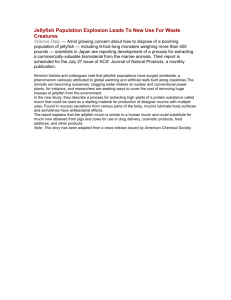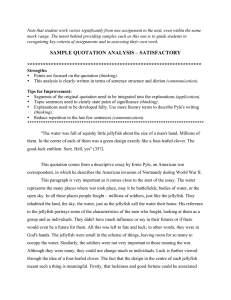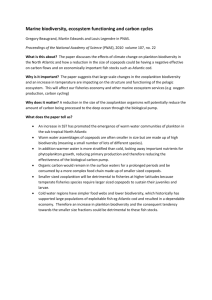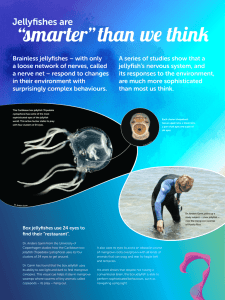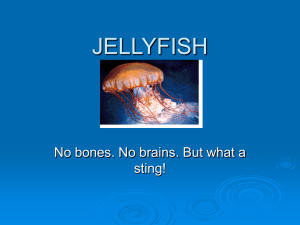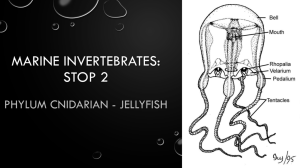North Atlantic climate and northwestern Mediterranean plankton variability Juan Carlos Molinero,
advertisement
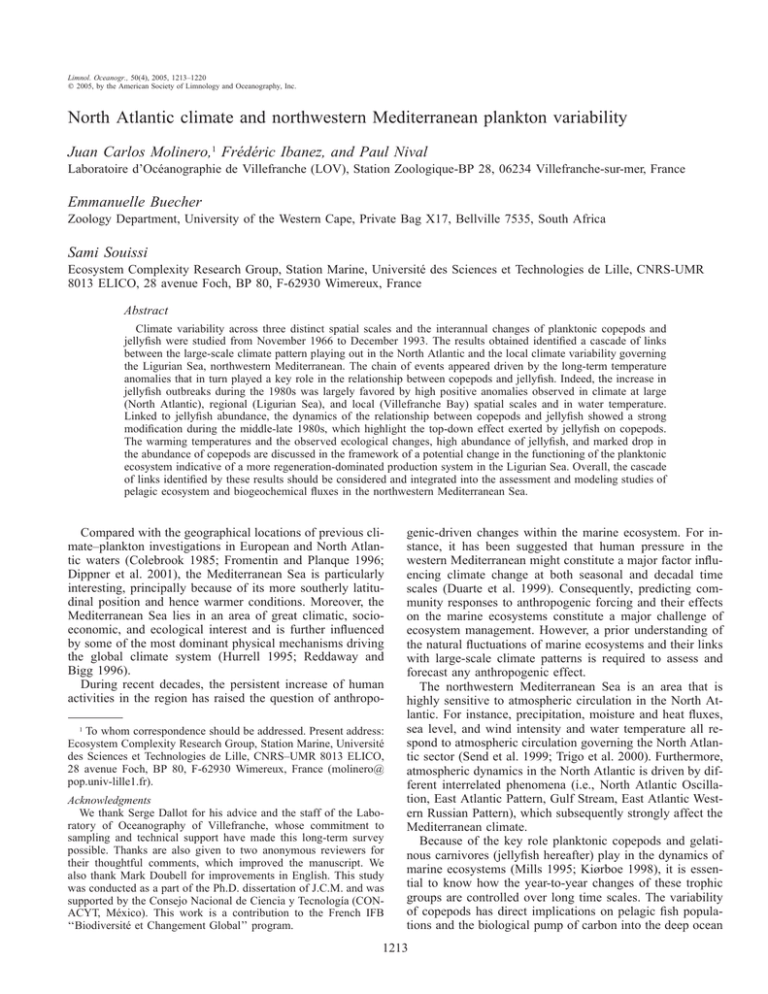
Limnol. Oceanogr., 50(4), 2005, 1213–1220 q 2005, by the American Society of Limnology and Oceanography, Inc. North Atlantic climate and northwestern Mediterranean plankton variability Juan Carlos Molinero,1 Frédéric Ibanez, and Paul Nival Laboratoire d’Océanographie de Villefranche (LOV), Station Zoologique-BP 28, 06234 Villefranche-sur-mer, France Emmanuelle Buecher Zoology Department, University of the Western Cape, Private Bag X17, Bellville 7535, South Africa Sami Souissi Ecosystem Complexity Research Group, Station Marine, Université des Sciences et Technologies de Lille, CNRS-UMR 8013 ELICO, 28 avenue Foch, BP 80, F-62930 Wimereux, France Abstract Climate variability across three distinct spatial scales and the interannual changes of planktonic copepods and jellyfish were studied from November 1966 to December 1993. The results obtained identified a cascade of links between the large-scale climate pattern playing out in the North Atlantic and the local climate variability governing the Ligurian Sea, northwestern Mediterranean. The chain of events appeared driven by the long-term temperature anomalies that in turn played a key role in the relationship between copepods and jellyfish. Indeed, the increase in jellyfish outbreaks during the 1980s was largely favored by high positive anomalies observed in climate at large (North Atlantic), regional (Ligurian Sea), and local (Villefranche Bay) spatial scales and in water temperature. Linked to jellyfish abundance, the dynamics of the relationship between copepods and jellyfish showed a strong modification during the middle-late 1980s, which highlight the top-down effect exerted by jellyfish on copepods. The warming temperatures and the observed ecological changes, high abundance of jellyfish, and marked drop in the abundance of copepods are discussed in the framework of a potential change in the functioning of the planktonic ecosystem indicative of a more regeneration-dominated production system in the Ligurian Sea. Overall, the cascade of links identified by these results should be considered and integrated into the assessment and modeling studies of pelagic ecosystem and biogeochemical fluxes in the northwestern Mediterranean Sea. Compared with the geographical locations of previous climate–plankton investigations in European and North Atlantic waters (Colebrook 1985; Fromentin and Planque 1996; Dippner et al. 2001), the Mediterranean Sea is particularly interesting, principally because of its more southerly latitudinal position and hence warmer conditions. Moreover, the Mediterranean Sea lies in an area of great climatic, socioeconomic, and ecological interest and is further influenced by some of the most dominant physical mechanisms driving the global climate system (Hurrell 1995; Reddaway and Bigg 1996). During recent decades, the persistent increase of human activities in the region has raised the question of anthropo1 To whom correspondence should be addressed. Present address: Ecosystem Complexity Research Group, Station Marine, Université des Sciences et Technologies de Lille, CNRS–UMR 8013 ELICO, 28 avenue Foch, BP 80, F-62930 Wimereux, France (molinero@ pop.univ-lille1.fr). Acknowledgments We thank Serge Dallot for his advice and the staff of the Laboratory of Oceanography of Villefranche, whose commitment to sampling and technical support have made this long-term survey possible. Thanks are also given to two anonymous reviewers for their thoughtful comments, which improved the manuscript. We also thank Mark Doubell for improvements in English. This study was conducted as a part of the Ph.D. dissertation of J.C.M. and was supported by the Consejo Nacional de Ciencia y Tecnologı́a (CONACYT, México). This work is a contribution to the French IFB ‘‘Biodiversité et Changement Global’’ program. genic-driven changes within the marine ecosystem. For instance, it has been suggested that human pressure in the western Mediterranean might constitute a major factor influencing climate change at both seasonal and decadal time scales (Duarte et al. 1999). Consequently, predicting community responses to anthropogenic forcing and their effects on the marine ecosystems constitute a major challenge of ecosystem management. However, a prior understanding of the natural fluctuations of marine ecosystems and their links with large-scale climate patterns is required to assess and forecast any anthropogenic effect. The northwestern Mediterranean Sea is an area that is highly sensitive to atmospheric circulation in the North Atlantic. For instance, precipitation, moisture and heat fluxes, sea level, and wind intensity and water temperature all respond to atmospheric circulation governing the North Atlantic sector (Send et al. 1999; Trigo et al. 2000). Furthermore, atmospheric dynamics in the North Atlantic is driven by different interrelated phenomena (i.e., North Atlantic Oscillation, East Atlantic Pattern, Gulf Stream, East Atlantic Western Russian Pattern), which subsequently strongly affect the Mediterranean climate. Because of the key role planktonic copepods and gelatinous carnivores (jellyfish hereafter) play in the dynamics of marine ecosystems (Mills 1995; Kiørboe 1998), it is essential to know how the year-to-year changes of these trophic groups are controlled over long time scales. The variability of copepods has direct implications on pelagic fish populations and the biological pump of carbon into the deep ocean 1213 1214 Molinero et al. (Ohman and Hirche 2001). Jellyfish variability directly affects the strength of the top-down control exerted on plankton communities through their feeding on eggs, fish larvae, and copepods (Mills 1995). Although the response to climate influence can vary between species, here we investigate whether the two trophic groups are differentially sensitive to climate forcing. This is important because climate influence can disrupt ecological interactions between trophic levels; consequently, the average sensitivity of the studied trophic groups could be useful to track changes at the community level. With the use of climatic indices, a number of studies over the last few decades have documented the presence of climate-driven changes on interannual variability in oceanic and limnological ecosystems (Gerten and Adrian 2000; Ottersen and Stenseth 2001). These observations seem to be driven by the prevailing Northern Hemisphere wintertime conditions, when the coupled ocean–atmosphere system is most active and strongly affects the hydrological dynamics of the North Atlantic. Climate therefore represents the main form of physical forcing on aquatic ecosystems (i.e., through the mixing of the water column and the subsequent availability of nutrients for phytoplankton blooms) in the North Atlantic and surrounding continents (Ottersen and Stenseth 2001). Furthermore, recent approaches have shown that regional indices could provide more detailed information on local climate variability because of their higher spatial resolution (Blenckner and Chen 2003). Such an approach allows a better comprehension of the existing links between climate at different scales. In this work, we have investigated climate variability across three distinct spatial scales and the corresponding long-term changes of two key trophic groups, planktonic copepods and jellyfish, at the local scale. The scaling of climate variability was defined for large (North Atlantic), regional (Ligurian Sea), and local (Villefranche Bay) scales. So far, no studies on the effects of regional climate variability effects on planktonic populations have been conducted in this region. We used a statistical approach to assess the degree of correlation between trophic groups and climatic variability and identified correlation channels through which climate shapes the patterns of abundance changes in the two trophic groups. Materials and methods Data—The time series of zooplankton abundance investigated in this study are unique in the Mediterranean Sea because of the consistency of the sampling methodology in terms of sampling frequency and the plankton quantification techniques maintained throughout the observational period. Plankton samples for analysis were collected weekly from November 1966 to December 1993 from a depth of 80 m (Point B: 438419N; 78199E) in the Ligurian Sea (NW Mediterranean; Fig. 1). The hydrodynamics of the area are influenced by both the Northern Current and open sea conditions because within close proximity of the sampling station, water depths reach 2,000 m. Plankton collection was performed by vertical hauls of a zooplankton net (Juday-Bogorov, 330 mm mesh size) from the bottom to surface. Samples were Fig. 1. Map of the western Mediterranean indicating the study area and mean circulation pattern: NC, Northern Current; WCC, Western Corsica Current; ECC, Eastern Corsica Current. The sampling station at the entrance of the bay of Villefranche (point B) is indicated. assessed taxonomically, and organisms were quantified at a species or genus level. Adult stages of five species of planktonic copepods were retained for analysis and included Centropages typicus, Temora stylifera, Acartia clausi, Oithona spp., and Oncaea spp. Jellyfish composition included Hydromedusae (Liriope tetraphylla, Solmundella bitentaculata, and Rhopalonema velatum), Scyphomedusae (Pelagia noctiluca), Siphonophores (Abylopsis tetragona and Chelophyes appendiculata), and Ctenophores (Pleurobrachia rhodopis). It is worth noting that catches of jellyfish and adults of Oithona spp. and Oncaea spp. are not sampled quantitatively. For instance, Calbet et al. (2001) showed that with a 200mm mesh size plankton net, assessment of abundance of copepods of small size (e.g., Oithona spp. and Oncaea spp.) is underestimated compared with abundances observed if a 53-mm mesh size net is used. In the case of jellyfish, the Juday–Bogorov net is not an appropriate sampling net because the small mesh size could damage gelatinous organisms. Subsequently, this prevents the use of such data as the real densities of these organisms. In our study, however, the high number of observations (1,405 samples) and use of the same strategy for organism sampling and quantification led to comparable data through time. Additionally, we investigated water temperature variability with the use of mean values for winter periods (December–March) recorded weekly at 1, 20, 50, and 75 m depth. Local meteorology (referred to as local climate hereafter) variability was achieved by means of monthly mean values of meteorological parameters (i.e., atmospheric pressure, air temperature, irradiance, and precipitation) derived from daily time series measurements at the Cap Ferrat Semaphore Mediterranean plankton and climate (;1.5 km from the study site) and used as indicators of local meteorological forcing. The regional-scale climate pattern during the study period was investigated with the use of atmospheric information from the 40-yr NCEP/NCAR reanalysis project (Kalnay et al. 1996). From this, an area extending from 68E to 108E and from 448N to 428N (Fig. 1), incorporating the whole Ligurian basin, was selected. The regional index was built with mean monthly values of sea surface temperature, atmospheric pressure, precipitation, and air temperature. Instead of treating large-scale climate patterns as separate phenomena, climatic indices were combined to build a signal that summarizes and represents the continuum of the North Atlantic climate (NAC) forcing. Moreover, by including all climatic indices, we greatly reduce the possibility of omitting signals that could be weak but biologically important (Taylor et al 2002; Voigt et al. 2003). Thus, NAC was estimated by the composition of the key modes of large-scale atmospheric circulation over the Northern Hemisphere (i.e., Arctic Oscillation [AO], North Atlantic Oscillation [NAO], East Atlantic pattern [EA], Gulf Stream/Northern Current Index [GSI], East Atlantic Western Russian Pattern [EA/WRUS], and Northern Hemisphere Temperature [NHT]). These data sets are freely available for the Atlantic sector at the Web sites www.cru.uea.ac.uk (NAO, NHT), http://www.cpc. ncep.noaa.gov/ (AO, EA, EA/WRUS), and www.pml.ac.uk/ gulfstream (GSI). Data analysis—First, to avoid nonstationary effects present in all time series, linear regression was performed to remove temporal trends, and residual values were retained for analysis. Second, principal component analysis (PCA) was performed to extract the main modes of temporal variability in physical (large-scale, regional, and local climates and water temperature) and biological (copepods and jellyfish) time series. Subsequently, each time series is expressed by means of its first three principal components (PCs). PCA axes are orthogonal and therefore independent of one another. This procedure creates composite independent climate variables and thus avoids spurious correlations inherent in a multivariate design with nonorthogonal climate factors (Voigt et al. 2003) which subsequently also led us to avoid trouble by correlations between the original variables. Third, canonical correlation analysis (CCA) was carried out for the leading eigenmodes of the NAC (predictor) and regional and local climates and zooplankton trophic groups (response) couples and between jellyfish (predictor) and copepods (response) to identify the possible correlation channels linking the two data sets. A similar approach has been used by Sirabella et al. (2001) to sketch the complexity of the link between climate and cod recruitment. To minimize the likelihood of committing a type I error when identifying links between climate and biological fields, we used a conservative alpha level of 0.01. Furthermore, the main pattern of variability in abundance of copepods and jellyfish, as shown by their first principal component, was projected into a two-axis space to show the dynamics of the link between the two trophic levels. 1215 Results The first three axes retained from the PCA output (Table 1) show that most of the variance for each data set is contained in these few variables (mean 87%, range 67–98%). Since the explained variance for climate data sets over the different scales was higher (mean 91%, range 82–98%) it highlights that these principal components explain most of the climatic forcing in the study area. The general trend of the NAC (PC1 47% of total variance) primarily represents large-scale temperature influence, as is shown by the principal component coefficients for all original climate variables (Table 1). A similar pattern is observed over regional and local scales of climate variability, for which a positive link between air and water temperatures and atmospheric pressure is also highlighted. For water column temperature, PC1 is primarily driven by the upper layers (surface, 10 and 50 m). PC2 for large-scale climate variability is driven by Eurasia and subtropical Atlantic influences (EA/WRUS and EA, respectively). At regional and local scales, it is driven by the long-term pattern of precipitation, whereas for the water column, it primary represents temperature variability in deep layers (75 m). PC3 mainly represents variability of the Gulf Stream effect over the large-scale climate, whereas over regional and local scales, it accounts for precipitation and irradiance variability. No significant contribution of PC3 was found for any temperature layer of the water column. For the two trophic groups, PC1 (52% and 33% for copepods and jellyfish, respectively) is represented mainly by species principally observed during the summer–autumn period, as shown by the component coefficients for the copepods Temora, Oithona, and Oncaea (positively correlated to the first axis) and Centropages (a spring-blooming copepod, negatively correlated to the axis) and the coefficients for the jellyfish Liriope, Rhopalonema, Solmundella, and Chelophyes. PC2 (23% and 20% for copepods and jellyfish, respectively) accounts for the variability of Acartia (PC2 copepods) and Pelagia (PC2 jellyfish). Finally, PC3 (14% in both copepods and jellyfish) mainly accounts for the variability of Centropages (PC copepods) and Pleurobraquia (PC jellyfish). The temporal trend of the main pattern of variability (PC1) for climate shows a remarkable synchronism between large, regional, and local scales (Fig. 2a). The pattern was characterized by an upward trend that reached its highest positive anomalies during the late 1980s and early 1990s. The long-term variability of water temperature (PC1) showed a slight downward trend before the 1980s followed by a marked upward pattern from the early 1980s to early 1990s (Fig. 2b). The observed trend (PC1) for jellyfish was similar to the temperature pattern (Fig 2c), particularly during the second half of the study period, in which maximal abundances of these groups were recorded. Finally, the observed trend for copepods (PC1) showed a cyclical pattern, which dropped strongly during the mid-1980s (Fig. 2d). Highly significant correlations between the interannual variability of climate over all three scales—large (North Atlantic), regional (Ligurian basin), and local (Villefranche 1216 Molinero et al. Table 1. Percentage of the total variance associated with the first three principal components (PCs) of the analyzed time series. The contribution to each PC formation, as indicated by the correlations coefficients of variables used in each PCA, is shown by significant coefficients (in italics). PC1 (47%) North Atlantic climate (NAC) Regional climate Local climate Water temperature Jellyfish Copepods North Atlantic Oscillation East Atlantic Pattern East Atlantic West Russian Pattern Gulf Stream Northern Hemisphere temperature Arctic Oscillation Sea surface temperature Air temperature Sea surface pressure Precipitation Geopotential height Precipitation Atmospheric pressure Irradiance Air temperature Surface 10 m 50 m 75 m Abylopsis Pleurobrachia Solmundella Pelagia Rhopalonema Chelophyes Liriope Temora Oithona Oncaea Centropages Acartia Bay)—and zooplankton abundance are evident from the canonical correlation coefficient values shown in Table 2. Correlations occurred mainly along the first principal components (i.e., NAC–regional climate, NAC–local climate, NAC–water temperature, and NAC–planktonic trophic groups), which constitute the main modes of temporal variability. These results highlighted a chain of events that link NAC effects and the variability of the northwestern Mediterranean climate at regional and local scales, through which NAC shapes the long-term changes of copepods and jellyfish. What is interesting is that the first principal component for large, regional, and local climate scales mainly represents factors governing the long-term temperature forcing in the western Mediterranean (Xoplaki 2002). Furthermore, it is worth noting that correlations between climate and water temperature occurred in several of the PC2 (22%) PC3 (12%) 0.43 20.60 20.70 20.16 0.06 0.49 20.22 20.15 20.33 0.51 0.37 20.34 PC1 (68%) PC2 (27%) PC3 (3%) 0.97 0.98 0.98 20.89 0.97 20.24 20.13 0.05 0.33 0.24 0.07 20.13 0.14 0.32 0.07 PC1 (62%) PC2 (16%) PC3 (15%) 20.68 0.61 0.35 0.79 0.33 20.09 20.23 20.30 0.49 20.55 20.72 20.18 PC1 (70%) PC2 (24%) PC3 (2%) 20.12 20.05 0.00 0.99 0.31 20.01 20.30 0.04 PC1 (33%) PC2 (20%) PC3 (14%) 0.52 20.36 0.66 0.23 0.66 0.79 0.60 20.59 0.09 0.23 0.92 20.03 0.21 20.28 20.39 20.67 20.43 20.10 0.39 0.06 20.06 PC1 (52%) PC2 (23%) PC3 (14%) 0.92 0.84 0.85 20.57 20.09 0.05 0.02 20.30 20.49 0.92 0.79 0.55 0.43 0.72 0.76 0.73 0.94 0.99 0.95 0.17 0.02 0.43 0.02 0.64 0.34 principal components, suggesting complex and not immediately recognizable links between climate and water temperature. Water temperature was also highly correlated with copepod and jellyfish abundance (as indicated by PC1). These results suggest that climate forcing on both trophic groups might act through water temperature changes. The canonical variables and Pearson correlation coefficients for the relationships between NAC, temperature, and both copepods and jellyfish are shown in Table 3. The first canonical correlations between copepods, jellyfish, and NAC are driven by PC1s, indicating a linear averaging effect during the wintertime on zooplankton groups. Indeed, high and similar correlation coefficients were observed over the first canonical correlation in the couples copepods (20.93) and NAC (20.99), and jellyfish and NAC both showing 20.98 (Table 3). Mediterranean plankton and climate 1217 Table 3. Upper canonical variables: North Atlantic climate (NAC) versus copepods (cops) and jellyfish. Correlation coefficients between principal components (PCs) and canonical variables that attained a statistical signficance for the NAC–trophic groups are indicated in italics. Bottom canonical variables: water temperature (temp) versus copepods and jellyfish. Large absolute values of correlation coefficients highlight the dominant role exerted by the corresponding components in driving the canonical variables. The highest contributions to canonical variables are in italics. Canonical variable 1 Fig. 2. Main pattern of long-term variability of the studied time series represented by the first PC: (a) North Atlantic (black line), regional (dotted line), and local climates (dashed line); (b) water temperature; (c) jellyfish; and (d) copepods. Although the influence of water temperature on copepods appears to be driven by subtle complex effects, in the case of jellyfish, a more direct linear relationship is observed (Table 3). For copepods, the first canonical correlation primarily represents PC1 of copepods and PC2 of water temperature (correlation coefficients 5 0.90 and 20.93, respectively). In the jellyfish case, the first canonical correlation was driven by the PC1s of both jellyfish and water temperature (correlation coefficients 5 20.93 and 20.84, respectively). Canonical variable 1 NAC–cops PC1NAC PC2NAC PC3NAC PC1cops PC2cops PC3cops 20.99 0.32 0.12 20.93 20.14 20.32 NAC–jellyfish PC1NAC PC2NAC PC3NAC PC1jellyfish PC2 jellyfish PC3 jellyfish 0.98 0.03 20.16 0.98 0.12 20.11 Temp–cops PC1temp PC2temp PC3temp PC1cops PC2cops Pc3cops 1 20.05 20.93 20.35 0.9 20.02 20.31 Temp–jellyfish PC1temp PC2temp PC3temp PC1jellyfish PC2 jellyfish PC3 jellyfish 1 20.84 20.48 20.25 20.93 0.33 0.13 We further considered the question of lag in the ecological response to NAC. Results obtained show that the effect of NAC on both copepods and jellyfish decreased but remained significant when considering a 1-yr lag (r13 5 20.59, p , Table 2. Canonical correlation coefficients relative to pairs of canonical variables for all between-field comparison. NAC, North Atlantic Climate; Ligure, regional climate; Vlfr, local climate; temp, water temperature. The statistically significant correlations are indicated in italics in parentheses. A conservative alpha level of 0.01 was used to minimize the likelihood of commiting type I error when identifying links between climate and biological fields. NAC/Ligure NAC/Vlfr CanCorr1 CanCorr2 CanCorr3 0.88(,0.01) 0.25(0.29) 0.16(0.22) 0.84(,0.01) 0.26(0.13) 0.1(0.54) Ligure/Vlfr Ligure/temp CanCorr1 CanCorr2 CanCorr3 0.89(,0.01) 0.46(0.07) 0.36(0.07) 0.79(,0.01) 0.29(0.60) 0.18(0.37) 0.71(0.03) 0.23(0.38) 0.14(0.39) Vifr/temp Vlfr/copepods Vlfr/jellyfish 0.64(0.04) 0.45(0.37) 0.05(0.81) 0.73(,0.01) 0.48(0.21) 0.05(0.80) CanCorr1 CanCorr2 CanCorr3 0.97(,0.01) 0.53(0.11) 0.08(0.71) Temp/copepods CanCorr1 CanCorr2 CanCorr3 0.55(0.05) 0.5(0.16) 0.08(0.72) Jellyfish/copepods CanCorr1 CanCorr2 CanCorr3 0.64(0.07) 0.35(0.47) 0.14(0.50) Temp/jellyfish 0.75(0.01) 0.29(0.61) 0.18(0.38) NAC/temp 0.67(0.01) 0.37(0.09) 0.02(0.17) Ligure/copepods NAC/copepods NAC/jellyfish 0.78(,0.01) 0.33(0.93) 0.03(0.63) 0.73(0.01) 0.29(0.95) 0.22(0.83) Ligure/jellyfish 0.67(0.05) 0.32(0.49) 0.21(0.32) 1218 Molinero et al. Fig. 3. Dynamics of the link between copepods and jellyfish during the period studied. The first PC represents each trophic group. The stable behavior observed during the years 1967–1985 was broken in 1986, a period associated with higher positive temperature anomalies. 0.01 for copepods; r9 5 0.6, p , 0.05 for jellyfish). However, for time lags .1 yr, the correlations become nonsignificant. The dispersion diagram of the main temporal pattern (PC1s) for interannual variability of the relationship between both copepod and jellyfish abundances shows a stable behavior during the period 1967–1986 that was broken during the late 1980s (Fig. 3). It is worth noting that this period was characterized by warm air and water temperatures and dry conditions, which seems to favor jellyfish blooms (Goy et al. 1989; Buecher 1999). Discussion The response of plankton to climate change has been investigated extensively in northern latitudes and temperate seas, and efforts have been particularly focused on the effects of the NAO (for a review, see Drinkwater et al. 2003). However, in the western Mediterranean region, such research has remained relatively scarce, mainly because of the lack of any long-term monitoring of plankton populations (CIESM 2003). Furthermore, the studies carried out on plankton populations all have focused on local environmental conditions (Menard et al. 1994; Buecher 1999; Licandro and Ibanez 2000). The statistically significant relationships found in this paper have shown that much of the variability of climate and zooplankton abundance in the Ligurian Sea, as represented by copepods and jellyfish, is governed by the variability of the winter NAC. It is suggested that such a link should not be restricted to only the observational site (Villefranche Bay), but that the effects of forcing as a result of the NAC occur over the entire Ligurian basin. The scaling of climate pointed out by these results provides sufficient support that the NAC constitutes the main physical forcing on the plankton ecosystem in the Ligurian Sea. The large-scale mechanisms that connect the Atlantic with the northwestern Mediterranean are linked to processes governing long-term temperature forcing (NAO, NHT, AO, GS, AE/WRUS), which during wintertime, control moisture and heat fluxes, precipitation, sea level, wind intensity, and water temperature over the western Mediterranean (Send et al. 1999; Trigo et al. 2000; Xoplaki 2002). Accordingly, regional and local climate showed a general pattern toward drier and warmer conditions throughout the 1980s, as indicated by a reduction in precipitation and a warming of air and water temperatures. It is likely that these properties are indicative of the characteristically drier winters experienced throughout southern Europe and the Mediterranean region that have been related to the strong positive NAO phase recorded since the 1980s (Hurrell 1995). In the Ligurian basin, the dominant hydrological features (i.e., Northern Current and Ligurian front) are associated with water flux variability through the Corsica channel (Astraldi 1995). The water mass transport from the Tyhrrenian Sea to the Ligurian Sea is in turn predominantly driven by wintertime atmospheric forcing (Astraldi 1995; Vignudelli et al. 1999), which is highly linked to the NAC, as showed by these results. Furthermore, these findings show that there is a strong relationship between the atmospheric sea level pressure field of the North Atlantic and the Ligurian climate at both basin and local scales. This relationship is predominantly driven by a chain of events extending from the effects of North Atlantic atmospheric circulation down to the regional and local values of atmospheric pressure, wind intensity, precipitation, and air and sea temperatures. This strongly supports the reported link between the atmospheric sea level pressure pattern governing the Ligurian Sea and the North Atlantic atmospheric circulation system (Reddaway and Bigg 1996; Vignudelli et al. 1999). Support for this is further given by the tight link between the Ligurian climate and NAC, as well as by the effect of high and low NAO values on water transport through the Corsica channel (Vignudelli et al. 1999). Indeed, low and high NAO (,21 and .1) values have been suggested as discriminating thresholds for atmospheric circulation in the Mediterranean region (Hurrell 1995; Vignudelli et al. 1999). Water temperature plays a key role in connecting largescale climate forcing to the interannual variability of zooplankton abundance in the Ligurian Sea. Furthermore, two types of effects on the trophic groups were highlighted: (1) direct effects on jellyfish, whose abundance was largely favored by warm water temperatures and dry conditions and by subsequent water column stability and (2) indirect effects on copepods, which have undergone higher predation pressure because of the increase in jellyfish outbreaks. This is supported by the abundances observed on summer–autumnblooming copepods (Temora, Oithona, Oncaea), driving the general pattern of copepod long-term variability (PC1). The effects of climate forcing on the interplay between the two trophic groups might further explain the stepwise change observed in the dispersion diagram between these groups. Indeed, the drop in copepod abundance occurred during the Mediterranean plankton and climate period of higher frequency and intensity of jellyfish outbreaks, which were likely favored by the higher positive anomalies in climate (large, regional, and local scales) and water temperature that occurred during the late 1980s. What emerges from our results is a close link between the long-term abundance variability of jellyfish and large-scale climate forcing, as indexed by the NAC. The changes promoted by such climatic forcing, particularly during the 1980s, led directly to low precipitation and wind stress values, as well as warm air and sea temperatures. These conditions could ultimately result in an increase in food availability for jellyfish (i.e., through the dominance of small-sized phytoplankton) and hence favor conditions for their development (i.e., warm temperatures, low water column mixing; Goy et al. 1989). Indeed, the relative stability of the water column, which is largely driven by atmospheric forcing, is a condition favorable to jellyfish outbreaks because it permits better survival and higher reproduction of jellyfish (CIESM 2001). As such, the above mechanisms might explain the close covariability observed between large-scale climate forcing and interannual changes in jellyfish abundance. Our results also highlight a complex effect of climate forcing on the interplay between trophic groups. Climate influence can change over time, as observed by the strong change in the dynamics between the two trophic groups that was associated with a period of favorable conditions for jellyfish development, and a subsequent increase in the frequency and intensity of jellyfish outbreaks. From these results, we hypothesize a change in the structure and functioning of the planktonic ecosystem indicative of a more regenerationdominated production system in the Ligurian Sea. We suggest that such changes occurred in response to the warmer temperature and the subsequent drier conditions that dominated the study area during the late 1980s. Although this hypothesis should be verified by investigating other functional groups and over a longer period of time, recent observations point indeed toward a change in the structure of the Ligurian planktonic ecosystem. For instance Marty and Chiaverini (2002) observed an increased numbers of smallsized phytoplankton linked to a lengthening of the stratification period, which is also linked to high temperature anomalies. Although recent studies have suggested an anthropogenic forcing on NAO variability, the dominant pattern of the NAO appears to be linked to the natural modes of climate system dynamics (Kirov and Georgieva 2002). Thus, our results indicate that the NAC drives a major component of the long-term changes of copepods and jellyfish, although an anthropogenic effect on zooplankton populations in the studied area is not excluded. The extent of forcing on jellyfish and copepods can vary depending on the existence of favorable conditions (i.e., warm temperatures, low water column mixing), which, on the basis of jellyfish life cycle characteristics (high spawning, developmental, and feeding rates), led this group to outcompete copepods. This suggest that at least one of the mechanisms linked to the decrease of copepods during warm temperature anomalies is related to high predation pressure as a result of an increase in jellyfish outbreaks. Species-specific responses to climate and 1219 comparative studies of food web structure in different Mediterranean areas are thus a challenge for future investigations. Our results point toward a trophic sensitivity to largescale climate forcing, which affects plankton ecosystem processes such as nutrient cycling and thereby the transfer of matter and energy in the pelagic ecosystem of the northwestern Mediterranean. They further provide the first observations of different trophic group responses in the study area to the ocean–atmosphere system in the North Atlantic. This study highlighted that climatic and plankton variability in the Ligurian Sea is part of the large-scale, longterm changes experienced in the North Atlantic. We believe these findings could have immediate implications deserving attention for assessment and modeling studies of the pelagic ecosystem and biogeochemical fluxes in the northwestern Mediterranean. They also draw attention to the dynamics of the principal food source for small pelagic fishes (i.e., anchovy, sardine) and a top predator (jellyfish), which are closely linked to the coupled ocean–atmosphere system in the North Atlantic. References ASTRALDI, M. 1995. Climatic fluctuations, current variability and marine species distribution, a case study in the Ligurian Sea (NW Mediterranean). Oceanol. Acta 18: 139–149. BLENCKNER, T., AND D. CHEN. 2003. Comparison of the impact of regional and North Atlantic atmospheric circulation on a aquatic ecosystem. Clim. Res. 23: 131–136. BUECHER, E. 1999. Appearance of Chelophyes appendiculata and Abylopsis tetragona (Cnidaria, Siphonophora) in the Bay of Villefranche, northwestern Mediterranean. J. Sea Res. 41: 295– 307. CALBET, A., S. GARRIDO, E. SAIZ, M. ALCARAZ, AND C. DUARTE. 2001. Annual zooplankton succession in coastal NW Mediterranean waters: the importance of the smaller size fractions. J. Plankton Res. 23: 319–331. CIESM. 2001. Gelatinous zooplankton outbreaks: theory and practice [Internet]. Monaco: CIESM Workshop Monograph 14 [accessed 15 March 2005]. 112 p. Available from www.ciesm.org/ publications/Naples01.pdf . 2003. Mediterranean biological time series [Internet]. Monaco: CIESM Workshop Monograph 22 [accessed 15 March 2005]. 142 p. Available from www.ciesm.org/publications/ Split03.pdf COLEBROOK, J. M. 1985. Sea surface temperature and zooplankton, North Sea, 1948 to 1983. J. Cons. Int. Explor. Mer 42: 179– 185. DIPPNER, J., J. HÄNNINEN, H. KUOSA, AND I. VUORINEN. 2001. The influence of climate variability on zooplankton abundance in the northern Baltic Archipelago Sea (SW Finland). ICES J. Mar. Sci. 58: 569–578. DRINKWATER, K., AND OTHERS. 2003. The response of marine ecosystems to climate variability associated with the North Atlantic Oscillation, p. 211–234. In J. W. Hurrell, Y. Kushnir, G. Ottersen, and M. Visbeck [eds.], The North Atlantic Oscillation: Climatic significance an environmental impact. Geophysical Monograph Series Volume 134. DUARTE, C., S. AGUSTI, H. KENNEDY, AND D. VAQUE. 1999. The Mediterranean climate as a template for Mediterranean marine ecosystems: The example of the northeast Spanish littoral. Prog. Oceanogr. 44: 245–270. FROMENTIN, J. M., AND B. PLANQUE. 1996. Calanus and environment in the eastern North Atlantic. II. Influence of the North 1220 Molinero et al. Atlantic Oscillation on C. finmarchicus and C. helgolandicus. Mar. Ecol. Prog. Ser. 134: 111–118. GERTEN, D., AND R. ADRIAN. 2000. Climate-driven changes in spring plankton dynamics and the sensitivity of shallow polimictic lakes to the North Atlantic Oscillation. Limnol. Oceanogr. 45: 1058–1066. GOY, J., P. MORAND, AND M. ETIENNE. 1989. Long-term fluctuations of Pelagia noctulica (Cnidaria, Scyphomedusa) in the western Mediterranean Sea. Prediction by climatic variables. Deep-Sea Res. 36: 269–279. HURRELL, J. W. 1995. Decadal trends in the North Atlantic Oscillation: Regional temperature and precipitation. Science 269: 676–679. KALNAY, E., AND OTHERS. 1996. The NMC/NCAR 40-year reanalysis project. Bull. Am. Meteorol. Soc. 77: 437–471. KIØRBOE, T., 1998. Population regulation and role of mesozooplankton in shaping pelagic food webs. Hydrobiologia 363: 13–27. KIROV, B., AND K. GEORGIEVA. 2002. Long-term variations and interrelations of ENSO, NAO and solar activity. Phys. Chem. Earth 27: 441–448. LICANDRO, P., AND F. IBANEZ. 2000. Changes of zooplankton communities in the Gulf of Tigulio (Ligurian Sea, western Mediterranean) from 1985 to 1995. Influence of hydroclimatic factors. J. Plankton Res. 22: 2225–2253. MARTY, J. C., AND J. CHIAVERINI. 2002. Seasonal and interannual variations of phytoplankton production at the DYFAMED time series station, northwestern Mediterranean. Deep Sea Res. II 49: 2017–2030. MENARD, F., S. DALLOT, G. THOMAS, AND J. C. BRACONNOT. 1994. Temporal fluctuations of two Mediterranean salp population from 1967 to 1990. Analysis of the influence of environmental variables using a Markov chain model. Mar. Ecol. Prog. Ser. 104: 139–152. MILLS, C. 1995. Medusae, siphonophores, and ctenophores as planktivorous predators in changing global ecosystems. ICES J. Mar. Sci. 52: 575–581. OHMAN, M. D., AND H. J. HIRCHE. 2001. Density-dependent mortality in an oceanic copepod population. Nature 412: 638–641. OTTERSEN, G., AND N. C. STENSETH. 2001. Atlantic climate governs oceanographic and ecological variability in the Barents Sea. Limnol. Oceanogr. 46: 1774–1778. REDDAWAY, J., AND G. BIGG. 1996. Climatic change over the Mediterranean and links to the more general atmospheric circulation. Int. J. Climatol. 16: 651–661. SEND, U., J. FONT, G. KRAHMANN, C. MILLOT, M. RHEIN, AND J. TINTORE. 1999. Recent advances in observing the physical oceanography of the western Mediterranean Sea. Prog. Oceanogr. 44: 37–64. SIRABELLA, P., A. GIULIANI, A. COLOSIMO, AND J. W. DIPPNER. 2001. Breaking down the climatic effects on cod recruitment by principal component analysis and canonical correlation. Mar. Ecol. Prog. Ser. 216: 213–222. TAYLOR, A., J. ALLEN, AND P. CLARK. 2002. Extraction of a weak climatic signal by an ecosystem. Nature 416: 629–632. TRIGO, I., T. DAVIES, AND G. BIGG. 2000. Decline in Mediterranean rainfall caused by weakening of Mediterranean cyclones. Geophys. Res. Lett. 27: 2913–2916. VIGNUDELLI, S., G. GASPARINI, M. ASTRALDI, AND M. E. SCHIANO. 1999. A possible influence of the North Atlantic Oscillation on the circulation of the western Mediterranean Sea. Geophys. Res. Lett. 26(5): 623–626. VOIGHT, W, AND OTHERS. 2003. Trophic levels are differentially sensitive to climate. Ecology 84: 2444–2453. XOPLAKI, E. 2002. Climate variability over the Mediterranean. Ph.D. thesis, Univ. of Thessaloniki, Greece. Received: 12 May 2004 Accepted: 17 December 2004 Amended: 23 February 2005
